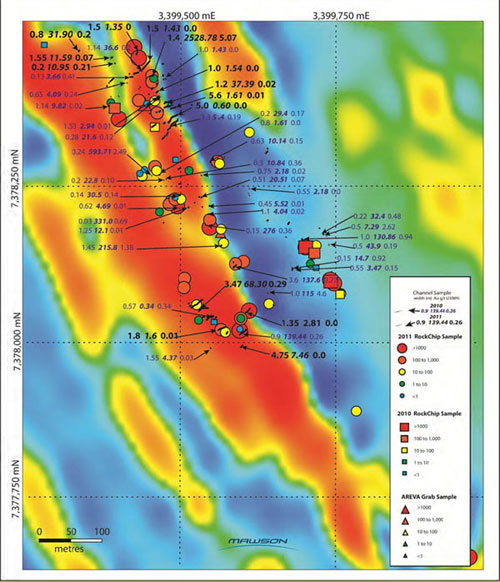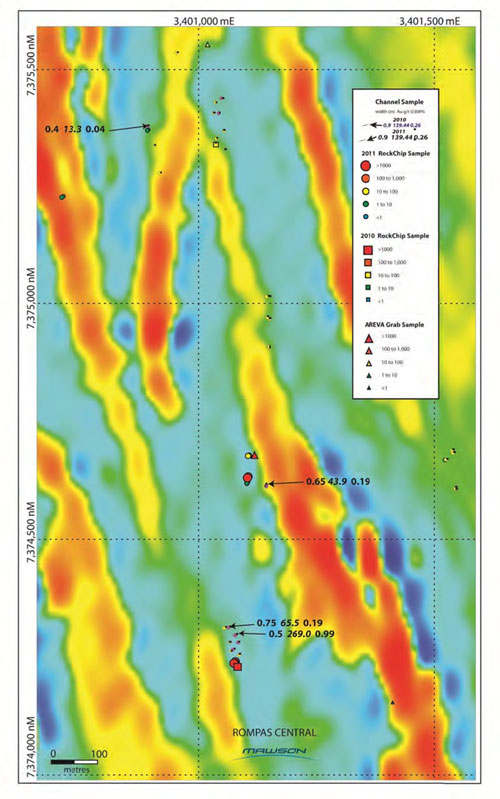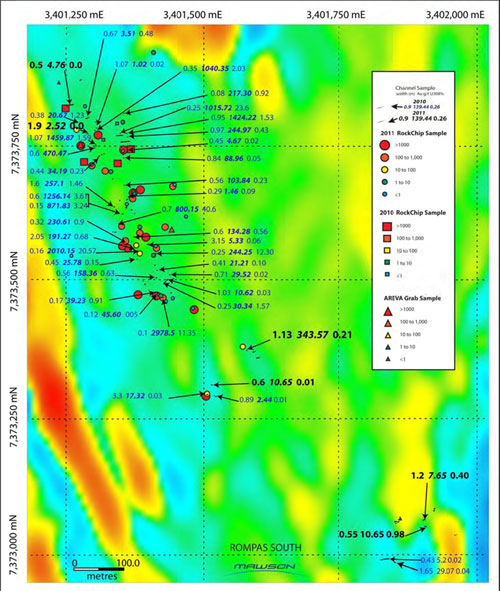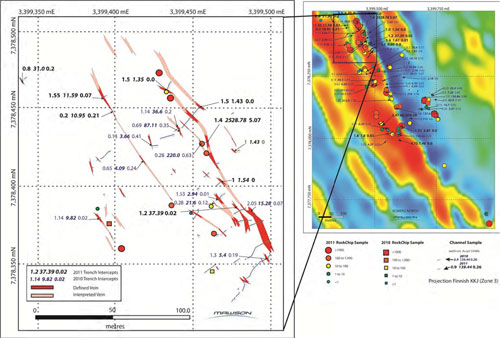Vancouver, Canada -- Mawson Resources Limited ("Mawson") TSX -- MAW; Frankfurt -- MRY. Mr Michael Hudson, President & CEO, announces new channel sample results from the 2011 exploration program and updates on work completed at the Company's 100% owned Rompas project in northern Finland.
Highlights include:
|
A detailed map showing the location and distribution of these and earlier channel and grab samples can be downloaded from the Company's website at http://www.mawsonresources.com/assets/docs/news/Rompas_PLANOCT312011.pdf (Figure 1).
These new channel sample results include the best surface trench sample discovered on the property to date of 1.40 m @ 2,529 g/t Au and 5.1 % U3O8 at North Rompas. This discovery was made under soil cover, in a location that was not known to be mineralized prior to manual excavation of the trench. Additional highlights include 1.13 m @ 343.6 g/t Au and 0.21 % U3O8 and 0.5 m @ 269.0 g/t Au and 0.99 % U3O8. In all, 152 diamond saw cut channel samples have been collected in 2011, for a total 732.3 metres of sampling. The weighted average of all 74 channel intervals from the 2011 program at Rompas that exceed the lower cut-off of 0.1 g/t gold or 100ppm uranium over one metre is 1.40 m @ 51.9 g/t Au and 0.13 % U3O8. Lengths of the channeled intervals ranged from 0.2 m to 8.8 m and the cumulative length of all channels above the lower cut-off of 0.1 g/t gold or 100ppm uranium was 88.0 m. Mineralized intervals that exceeded a higher +1 g/t gold lower cut-off over one metre are show in Table 1.
As the Rompas project is secured by exploration claim applications, sampling has been restricted to hand trenching through soil to access bedrock for diamond saw channel sampling. In many cases continuous cut channels are interrupted by deeper weathered zones, especially when carbonate rich gold and uranium mineralization is present. In these cases weathered bedrock is sampled as a channel, but with a lower level of confidence in the insitu grade of mineralization than the unweathered channels.
Supported by this new set of trench sampling results, the Company believes the 2011 work program at Rompas has been successful in:
- EXTENDING THE MINERALIZED ZONE
Prospecting during this field season has significantly expanded the mineralized area (Figure 1). The footprint of mineralization now extends over greater than 6km in strike and up to 270 metres in width. Data from North Rompas (Figure 2), the newly discovered Central Rompas (Figure 3) and South Rompas (Figure 4) has provided a much clearer picture of grade and distribution of mineralization.
New bedrock discoveries in addition to those provided above include:- 0.8m @ 31.90 g/t Au and 0.20% U3O8 made 50 m north west of previous known mineralization in North Rompas;
- 0.5m @ 269.00 g/t Au and 0.99% U3O8 and 0.75m @ 65.60 g/t Au and 0.19% U3O8 made 450m northof South Rompas (now Central Rompas);
- 0.65m @ 43.90 g/t Au and 0.19% U3O8 made 800 m north of South Rompas (now Central Rompas);
- 0.5m @ 10.55 g/t Au and 0.04% U3O8 and 0.55m @ 10.65 g/t Au and 0.98% U3O8 made 450m south east of South Rompas.
- DEMONSTRATING CONTINUITY BETWEEN HIGH GRADE GOLD AND URANIUM SITES DISCOVERED DURING THE 2010 PROGRAM
New mapping and detailed trench sampling data has demonstrated continuity of gold anomalous zones for the first time at the project so identifying high priority drill targets. Detailed trench sampling was used to expand across zones previous only known for spot high grade gold and uranium. In the northern zone of North Rompas, en echelon and continuous mineralization has now been defined at a consistent grade of +0.1 to 0.5 g/t gold over at least 130 m of strike. Four main intervals were defined across a 55 m wide zone (Figure 5) with intermittent high grade gold and uranium values.
- DETERMINING WALL/COUNTRY ROCK GRADE ON THE MARGINS OF BONANZA GRADE GOLD LOCATITIES
Radioactive prospecting was the principal exploration technique applied by Mawson in 2010, which proved very successful in the discovery of high grade uranium (and gold) mineralization under thin soil cover. This technique, however, provides little information on the continuity of mineralization at lower grades and the mineralization potential of non-radioactive rocks at Rompas. In 2011, many gold occurrences have been discovered with minor or no uranium. Examples are 4.75 m @ 7.46g/t Au and 39.2ppm U3O8 (TR108550), 0.7m @ 5.58 g/t Au and 14.2ppm U3O8 (TR108518b) and 1.5 m @ 1.43g/t Au and 2.5ppm U3O8 (TR108566). As only about 10% of bedrock outcrops in the discovery area, these 'gold only' samples indicate significant potential to make further discoveries that are invisible to radiometric prospecting.
Additionally, further mineralization has been found in country rock adjacent to some of the high grade mineralized intervals discovered in 2010. For example, the previously reported 2010 trench 107429 returned 0.77m @ 301.75 g/t Au and 1.29% U3O8. Further trenching to the west and across strike extended this intersection in trench TR108555 to a combined result of 3.47m @ 68.30 g/t Au and 0.29% U3O8 in trench comb_107429_TR108555.
"Mawson has significantly advanced its understanding of the Rompas gold project during this year's field season. The good news is that the more we look at Rompas, the more mineralization we find across a broad surface area predominately covered by shallow glacial soils. This year's program has been successful in achieving its multiple aims. The project is now ready for drilling to test its potential in the third dimension. Given the scale and tenor of mineralization found to date, Mawson is committed to a large drill program once exploration claims are granted" said Mr Hudson.
The Rompas mineral system is hosted by metabasalt, dolomite, calc-silicate, dolerite and volcaniclastics, all part of the Palaeoproterozoic Perapohja Schist Belt. These rocks have undergone at least two major deformation events, leading to a locally strong schistosity (oriented 320-340 degrees) and metamorphism up to amphibolite-grade resulting in diopside-tremolite-actinolite assemblages in the calc-silicate rocks.
Gold and uranium mineralization at Rompas is hosted by a quartz-calc-silicate vein array and related alteration selvedges. The veins are typically composed of calc-silicate minerals (diopside-tremolite-actinolite-calcite-quartz +/- uraninite, gold) with alteration selvedges of amphibole-biotite-albite-K feldspar. Individual veins at Rompas are up to 1m wide, with alteration selvedges of similar widths to the veins, but are part of a much larger, interconnected vein array. The veins appear to have been emplaced prior to the main deformation event, are deformed by it, and are metamorphosed, although a small percentage of veins are within the main cleavage. The deformation event has affected the veins, which are locally boudinaged and folded.
The spectacular, bonanza gold and uranium grades are generally contained in pods of calcite, amphibole and uraninite, often associated with boudinaged "ladder veins" within the more extensive vein system, indicating they could be local upgraded remobilizations from the veins. 2011 sampling has extended the footprint of the mineralization at North Rompas, and at South Rompas into Central Rompas over 6 km by 270 m wide. The 'footprint' approximates the extent of the known vein array. At present there appear to be two vein arrays at North and South to Central Rompas over a combined strike length of 3.5km; however there is little outcrop between these zones. Controls on the mineralization and vein distributions are not known as yet. All the known gold and uranium occurrences at Rompas are on a NNW trending ridge, with scattered outcrop (including mineralization) with 90% of the area masked by 0.5 to 5 metre thick soil and till cover. The ridge is surrounded by thicker till and soil and at times mineralization appears to continue below this thicker cover.
Other work during the 2011 field season has included:
- Mapping at 1:5000 over the prospect area and 1:1000 scale mapping over mineralized zones.
- Follow up till and organic surface soil sampling has continued to follow up anomalies from 2010. The known mineralized zones are defined in these geochemical data, and many additional anomalies have been discovered that require follow up.
- 5 line km of dipole-dipole IP and 22 line km of gradient array IP have been collected over the prospect area and results are currently being processed and assessed.
- Accurate surveying by differential GPS of all trenches, samples points and key outcrops. Additionally a surveyed baseline and staked grid has been established over the entire project area.
Being a new discovery the Rompas project is secured by claim applications. Deep drilling and mechanical trenching will be permitted on the granting of exploration claims. The granting of claims in Finland is currently slow and Mawson is working with the Finnish authorities to facilitate this process in the shortest possible time. Further information regarding the permitting for this program will be announced as further news comes available.
Shares Outstanding: 51,670,753; Cash: approximately C$11 million.
|
On behalf of the Board, "Michael Hudson" |
Investor Information |
Forward Looking Statement. The statements herein that are not historical facts are forward-looking statements. These statements address future events and conditions and so involve inherent risks and uncertainties, as disclosed under the heading "Risk Factors" in the company's periodic filings with Canadian securities regulators. Actual results could differ from those currently projected. The Company does not assume the obligation to update any forward-looking statement. The TSX Exchange has not reviewed and does not accept responsibility for the adequacy or accuracy of this release.
Mawson samples were prepared by ALS Chemex Ltd's laboratory in Pitea, Sweden and analyzed by Au-ICP21, ME-MS41u, PGM-ICP27 and ME-MS61u techniques by ALS Chemex Ltd's laboratory in Vancouver, Canada and Saskatchewan Research Council using standard ICP partial and full digestion and fire assay methods. The qualified person for Mawson's Finnish projects, Mr Terry Lees, VP Exploration for Mawson and Fellow of the Australian Institute of Geoscientists has reviewed and verified the contents of this release.
Table 1: Best results from the 2011 Channeling Sampling Program (1 g/t gold lower cut-off over one metre)
| TRENCH NUMBER | RESULT |
|---|---|
| TR108915 | 1.4m @ 2528.78 g/t Au and 5.07% U3O8 including 0.2m @ 17,700g/t Au and 35.5% U3O8 |
| TR108929 | 1.13m @ 343.57 g/t Au and 0.21% U3O8 |
| comb_107429_TR108555* | 3.47m @ 68.30 g/t Au and 0.29% U3O8* |
| TR108907b | 0.5m @ 269.00 g/t Au and 0.99% U3O8 |
| TR108904b | 0.75m @ 65.60 g/t Au and 0.19% U3O8 |
| TR108572 | 1.2m @ 37.39 g/t Au and 0.02% U3O8 |
| TR108550 | 4.75m @ 7.46 g/t Au and 0.00% U3O8 |
| TR108908 | 0.65m @ 43.90 g/t Au and 0.19% U3O8 |
| TR108923 | 0.8m @ 31.90 g/t Au and 0.20% U3O8 |
| TR108570 | 1.55m @ 11.59 g/t Au and 0.07% U3O8 |
| TR108518+b | 1.2m @ 7.65 g/t Au and 0.40% U3O8 |
| TR108562 | 5.6m @ 1.61 g/t Au and 0.01% U3O8 |
| TR108521 | 0.6m @ 10.65 g/t Au and 0.01% U3O8 |
| TR108519 | 0.55m @ 10.65 g/t Au and 0.98% U3O8 |
| TR108514 | 0.4m @ 13.30 g/t Au and 0.04% U3O8 |
| TR108534 | 1.9m @ 2.52 g/t Au and 0.00% U3O8 |
| TR108543 | 1.35m @ 2.81 g/t Au and 0.00% U3O8 |
| TR108559 | 5m @ 0.60 g/t Au and 0.00% U3O8 |
| TR108551 | 1.8m @ 1.60 g/t Au and 0.01% U3O8 |
| TR108535 | 0.5m @ 4.76 g/t Au and 0.00% U3O8 |
| TR108571 | 0.2m @ 10.95 g/t Au and 0.21% U3O8 |
| TR108566 | 1.5m @ 1.43 g/t Au and 0.00% U3O8 |
| TR108569 | 1.5m @ 1.35 g/t Au and 0.00% U3O8 |
| TR108563 | 1m @ 1.54 g/t Au and 0.00% U3O8 |
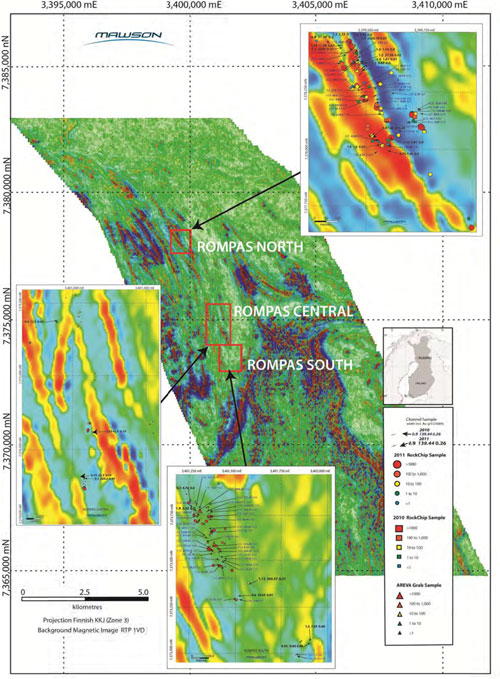
Detailed Image can be downloaded from:
http://www.mawsonresources.com/assets/docs/news/Rompas_PLANOCT312011.pdf
